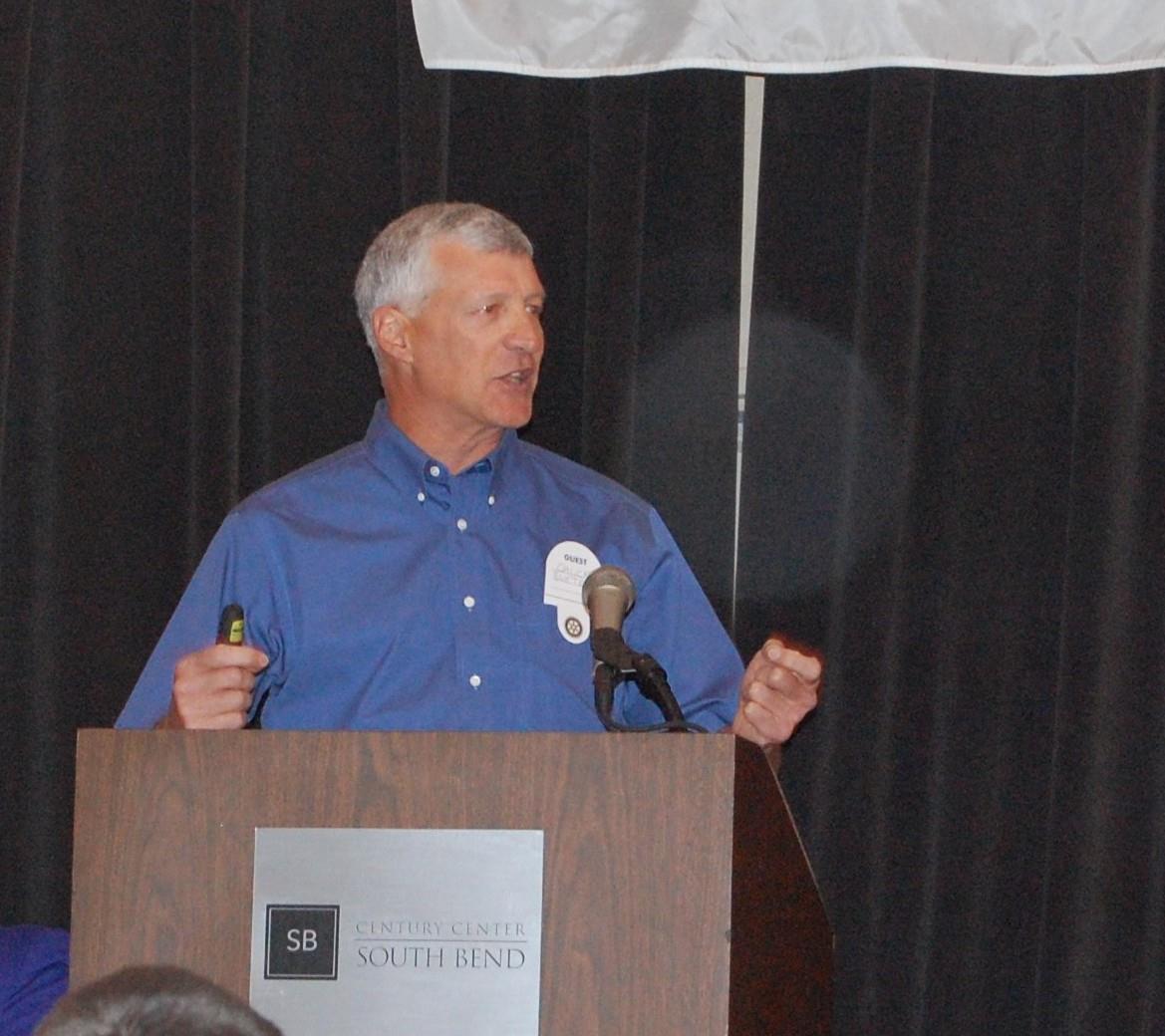MEETING NOTES
Posted by Beth North
on May 07, 2015
 Pete Owsianowski introduced today’s program speaker Chuck Buetter, an amateur astronomer, and President of the Michiana Astronomical Society, who first came to appreciate the night sky while working aboard boats on the Great Lakes. He spearheaded “Let There Be Night” – a program where 3,400 local students worked to estimate how much of the night sky has already been lost to light pollution. Chuck introduced us to the official star of the SB150 celebration, Altanin, 150 light years away from the earth, which will be visible in the North sky during the May 22nd celebration of South Bend’s 150th year since incorporation. He ponders whether, given the trends, it will be possible to see the bi-centennial star of South Bend, Sheaht. And, let’s not forget Astrocamp at Camp Eberhardt the week of July 12th. Chuck’s also been working in conjunction with James Summers to be intentionally inclusive and provide SB150 Young Astronomers to learning about telescopes and having access to an online network of research grade telescopes. They will request images, then download, print and hopefully, display their work. This will hopefully lead to self-directed research projects. Volunteers who have office windows high up in South Bend’s tall buildings are encouraged to help by volunteering to post a KEYWORD for local SB150 Young Astronomers, to use the galileoscopes they are building to spot these KEYWORDs , as a learning experience. Be on the lookout September 27th starting just after 9 pm for the total lunar eclipse. He encouraged us to appreciate and learn about the night sky and stars and galaxies at the four area planetariums – Penn Harris Madison Schools (PHM), Notre Dame, Kennedy Primary (SB Schools), and at the Ecoscience Center, noting the imminent retirement of Art Klinger from PHM and thanking him for all his contributions to teaching young people about astronomy. He spoke of the SB Career Academy’ Sunfunnel project – in hopes to commercialize in time for safely viewing the August 21, 2017 total solar eclipse – projected to be the most observed celestial phenomenon ever in the US. Chuck brought the human health impact of too much blue light and insufficient darkness. The drop in melatonin has been connected with incidence of breast cancer and the WHO putting “shift work” on their probable carcinogen list. Chuck and Pete urge us to take time to appreciate things like cool things happening on the surface of our own star, the sun. Remember the importance of stars every time you see the US or Indiana flags, which both feature stars in their designs. Lastly, anyone planning an outdoor project involving lighting, please call Chuck before you start in order to consider the impact and best practices for retaining our dark night sky, even while providing safe night lighting.
Pete Owsianowski introduced today’s program speaker Chuck Buetter, an amateur astronomer, and President of the Michiana Astronomical Society, who first came to appreciate the night sky while working aboard boats on the Great Lakes. He spearheaded “Let There Be Night” – a program where 3,400 local students worked to estimate how much of the night sky has already been lost to light pollution. Chuck introduced us to the official star of the SB150 celebration, Altanin, 150 light years away from the earth, which will be visible in the North sky during the May 22nd celebration of South Bend’s 150th year since incorporation. He ponders whether, given the trends, it will be possible to see the bi-centennial star of South Bend, Sheaht. And, let’s not forget Astrocamp at Camp Eberhardt the week of July 12th. Chuck’s also been working in conjunction with James Summers to be intentionally inclusive and provide SB150 Young Astronomers to learning about telescopes and having access to an online network of research grade telescopes. They will request images, then download, print and hopefully, display their work. This will hopefully lead to self-directed research projects. Volunteers who have office windows high up in South Bend’s tall buildings are encouraged to help by volunteering to post a KEYWORD for local SB150 Young Astronomers, to use the galileoscopes they are building to spot these KEYWORDs , as a learning experience. Be on the lookout September 27th starting just after 9 pm for the total lunar eclipse. He encouraged us to appreciate and learn about the night sky and stars and galaxies at the four area planetariums – Penn Harris Madison Schools (PHM), Notre Dame, Kennedy Primary (SB Schools), and at the Ecoscience Center, noting the imminent retirement of Art Klinger from PHM and thanking him for all his contributions to teaching young people about astronomy. He spoke of the SB Career Academy’ Sunfunnel project – in hopes to commercialize in time for safely viewing the August 21, 2017 total solar eclipse – projected to be the most observed celestial phenomenon ever in the US. Chuck brought the human health impact of too much blue light and insufficient darkness. The drop in melatonin has been connected with incidence of breast cancer and the WHO putting “shift work” on their probable carcinogen list. Chuck and Pete urge us to take time to appreciate things like cool things happening on the surface of our own star, the sun. Remember the importance of stars every time you see the US or Indiana flags, which both feature stars in their designs. Lastly, anyone planning an outdoor project involving lighting, please call Chuck before you start in order to consider the impact and best practices for retaining our dark night sky, even while providing safe night lighting.